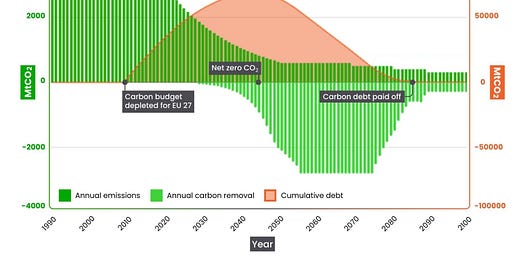Today a new paper I've written with Eli-Mitchell Larson for Carbon Gap is released! In it, we argue that all new CO₂ emissions from countries with large historic emissions need to be removed. Their national budgets are depleted under any equitable division of the remaining global carbon budget.
Key points in the paper are:
Large historic emitters do not have any remaining carbon budget.
Countries with significant past emissions have exceeded their fair share and now accumulate carbon debt with each new emission.
Emissions in excess of carbon budgets need to be removed.
All excess emissions—past, present, and future—must be removed to prevent unsafe temperature overshoot.
Emission reductions still take precedence in most cases, but some emissions are "CDR-optimal".
While eliminating emissions is the priority, some are best addressed through carbon removal, termed "CDR-optimal". This term will be further defined in an upcoming Carbon Gap paper.
The terms "excess" and "CDR-optimal" emissions provide more precision than "residual emissions," which is used inconsistently.
Using "excess" and "CDR-optimal" clarifies which emissions need removal, unlike the inconsistent term "residual emissions" which needs to be specified when used to determine if it refers to sectors of emissions, all emissions remaining at net zero, or CDR-optimal emissions. The paper goes into detail of different uses of the term residual emissions.
Carbon removal is at limited risk of creating stranded assets.
Investing in carbon removal is essential and low-risk due to the ongoing need to address accumulating carbon debt. CDR capacity won’t become stranded assets, even if the number of “CDR-optimal emissions” were to be very small.
In the paper, we use the EU as an example. showing that under reasonable assumptions the union’s carbon debt already exceeds 40 Gt CO₂ and may peak around 70 Gt CO2 in 2045 at the point of net zero.
This example builds on data from a pre-print paper (Hahn et al 2023) where I am a co-author. The final version of that paper will be published soon.
A key conclusion from all of this is that the need to address emissions exceeding carbon budgets is the biggest role for carbon removal. Using removals for residual CDR-optimal emissions is the smaller use case.
This paper, together with the upcoming one on CDR-optimal emissions have been work in progress for a long time and I am very happy to finally be able to release it.
Please share your comments!





Interesting and helpful.
I appreciate that an effort is made to support fairness as an approach in the ongoing negotiations by providing background and indicators.
One question in regard to Carbon Removals and CDR-optimal: What role (if any) do you forsee for the VCM in this context (also refering to your Email/Newsletter on the 14th of Oct.)?